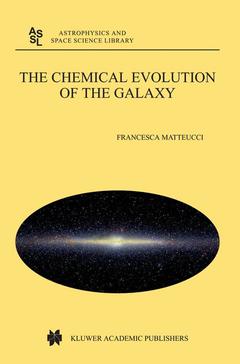The Chemical Evolution of the Galaxy, 2003 Astrophysics and Space Science Library Series, Vol. 253
Langue : Anglais
Auteur : Matteucci Francesca

This book is based partly on a. lecture course given at the University of Tri este, but mostly on my own research experience in the field of galactic chemical evolution. The subject of galactic chemical evolution was started and developed by Beat rice Tinsley in the seventies and now is a flourishing subject. This book is dedi cated to the chemical evolution of our Galaxy and aims at giving an up-to-date review of what we have learned since Tinsley's pioneering efforts. At the time of writing, in fact, books of this kind were not available with the exception of the excellent book by Bernard Pagel on "Nucleosynthesis and Chemical Evolution of Galaxies" (Cambridge University Press, 1997), and the subject of galactic chem ical evolution has appeared only as short chapters in books devoted to other subjects. Therefore, I felt that a book of this kind could be useful. The book summarizes the observational facts which allow us to reconstruct the chemical history of our Galaxy, in particular the abundances in stars and in terstellar medium; in the last decade, a great deal of observational work, mostly abundance determinations in stars in the solar vicinity, has shed light on the pro duction and distribution of chemical elements. Even more recently more abun dance data have accumulated for external galaxies at both low and high redshift, thus providing precious information on the chemical evolution of different types of galaxies and on the early stages of galaxy evolution.
1. Observational Evidence for Chemical Evolution.- 1.1 Overview and historical perspective.- 1.2 Abundances in stars.- 1.3 Abundances in globular clusters.- 1.4 The metallicity distribution of the local disk G-dwarfs.- 1.5 The metallicity distribution of halo stars.- 1.6 The age-metallicity relation.- 1.7 Abundances in the bulge stars.- 1.8 Abundances from planetary nebulae.- 1.9 Abundances from HII regions, B stars, open clusters.- 1.10 Isotopic ratios.- 1.11 The abundances of light elements.- 1.12 The mass distribution in the Galaxy.- 1.13 Supernovae and supernova rates.- 1.14 Nova rates.- 2. Stellar Evolution and Nucleosynthesis.- 2.1 The evolution of single stars.- 2.2 Nucleosynthesis.- 2.3 The evolution of binary systems.- 2.4 Stellar yields.- 2.5 Local abundances and nuclear processes.- 2.6 Algorithms to compute the stellar yields.- 2.7 The influence of mass loss and overshooting on the stellar yields.- 2.8 Galactic yields.- 3. The Stellar Birthrate.- 3.1 The process of star formation.- 3.2 Derivation of the stellar birthrate.- 3.3 The parametrizations of the SFR.- 4. Gas Flows.- 4.1 Infall of gas onto the Galaxy.- 4.2 Radial flows along the galactic disk.- 4.3 Galactic winds.- 5. Basic Equations of Chemical Evolution.- 5.1 Analytical models.- 5.2 Numerical models.- 5.3 Chemo-dynamical models.- 6. Formation and Evolution of the Milky Way.- 6.1 Abundances and kinematics.- 6.2 The globular clusters ages and the formation of the halo.- 6.3 Abundance ratios and galaxy formation.- 6.4 Serial formation.- 6.5 Parallel formation.- 6.6 Two-infall formation.- 6.7 The evolution of the solar neighbourhood.- 6.8 The evolution of the galactic disk.- 6.9 The evolution of light elements and their impact on cosmology.- 6.10 The chemical evolution of the galactic bulge.- 6.11 How reliable are chemical evolution models?.- 7. Nucleochronology and the Age of the Galaxy.- 7.1 Radioactive dating of elements.- 7.2 The age of the galaxy.- 8. The Milky Way and other Spiral Galaxies.- 8.1 Abundances and abundance gradients.- 8.2 Correlations between abundances and galaxy properties.- 8.3 Field and cluster spirals.- 8.4 Formation and evolution of galactic disks.- 8.5 The Milky Way at high redshift.- 9. References.- Acknowledgments.
Date de parution : 06-2001
Ouvrage de 285 p.
15.5x23.5 cm
Thème de The Chemical Evolution of the Galaxy :
Mots-clés :
Galaxy; Variation; galaxies; milky way; star; star formation; stellar; stellar evolution
© 2024 LAVOISIER S.A.S.



